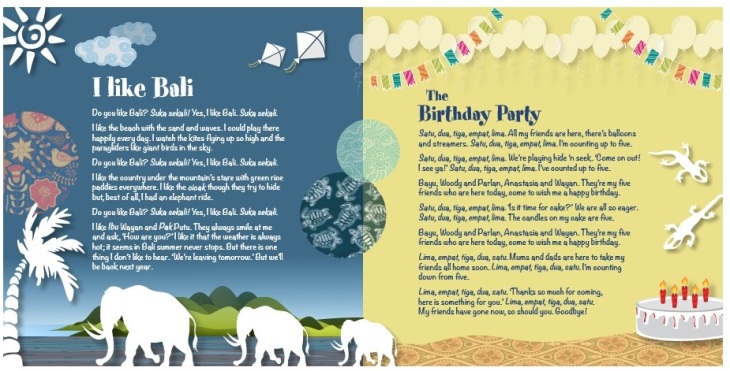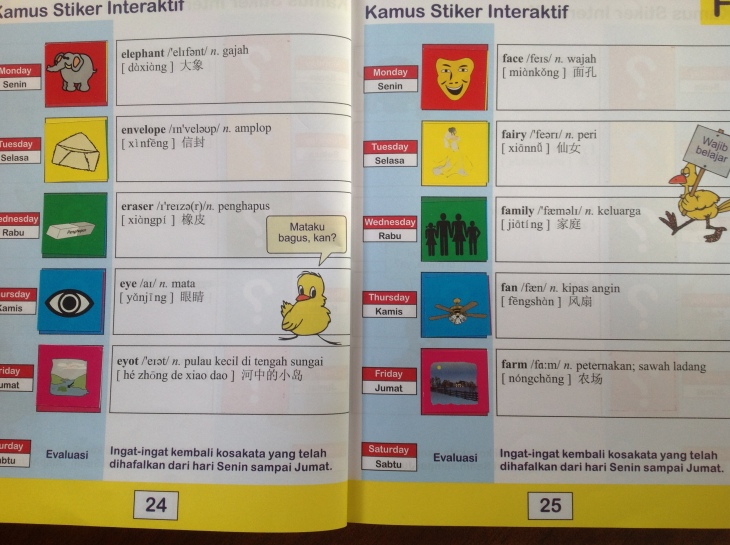I had a chat with Sarita Newson last year about the latest children’s book she is publishing. With more than 30 years of experience in publishing in Indonesia through her company Saritaksu Editions, Sarita Newson is a wealth of interesting stories and useful information. This is part of our conversation.
How did you begin publishing children’s books?
We did one way back with an Australian friend of mine Adrian Clynes who is a linguist – his thesis was on the language of Bali. He put together some of the stories that the old people used to tell. We were concerned they were getting lost as the oral tradition petered out with the arrival of TV. That book was called Grandfather’s Tales – Kakek Bali Bercerita. We sort of self-published it. There wasn’t any proper distribution in those days but Bali is small enough you can spread them about. It was very popular.
At that time, the early eighties, there were very few books for children in bookstores. You could only get Majala Bobo. There weren’t any of the lovely colourful picture books in Indonesian in those days. Now there are some wonderful comic books and picture books.
Tell us about your latest book Rajawali and the Children: Making the lake clean
It is the third book in the Clean Bali series of books written by Maggie Dunkle and illustrated by Margiyono. [Maggie Dunkle was a librarian and author who moved from Australia to Bali late in life and passed away in 2012.]
The book is trying to point out the wisdom of nature. How the birds know how to survive and how we should listen and observe. If the birds leave, it’s for a very good reason. There is a reason they are dying.

How long does it take to publish a children’s book?
One book can take six months to a year from taking a manuscript through translation, illustration and printing. This one has taken longer. We ran out of steam. The illustrator got busy, but I wanted to keep the same artist the same way through as I wanted them to look the same. He spent a lot of time learning about the different birds in Bali and trying to depict them accurately.
Another thing that slowed us down was that the author Maggie got very ill and passed away. She was a great force for pushing things along. She was a very grumpy old lady. I was very fond of her and we never had an argument, but she had arguments with everyone else.
 How did you find the illustrator?
How did you find the illustrator?
The illustrator, Margiyono, was working as a stonemason. A friend saw some paintings he was doing and asked, ‘have you ever tried to illustrate anything?’ She encouraged him to do some illustrations and when they had some, they came to me. I told them there is a lot more work to do but I’d love to publish it.
All three books in the Clean Bali Series are printed in Balinese, Indonesian and English. I did the Indonesian translation with the help of my son. And Balinese author Made Taro translated the Bahasa Bali.
What are some of the practicalities of publishing in Indonesia?
It is most important to have a good printer who will be responsible for quality. Not all printers have the equipment or know-how to print books, or the ethics that are necessary, when printing mistakes happen. It is important to be clear on responsibility, and to have a good quality control. Just as with any other production, rushing orders is not a good idea, as it doesn’t allow enough time for checking and control. Storage is also important – it must be airconditioned and/or dehumidified in the tropics.
What are the steps involved in setting up a publishing company in Indonesia?
First one has to be Indonesian, and have a legal, registered, tax-paying company. Second, one needs to have a reliable and trustworthy printer. Third, a team who are willing and able to distribute and follow up with book shops and other places that sell the books.
Is it possible to self-publish?
It is possible to self-publish, but it is important to have a good editor, as few writers are capable of editing their own work. Self-publishers need to be savvy in promoting their own books, both digital and printed, as they are on their own. Preferably they should have their own network or access to buyers for selling the books, as book shops are not always keen to accept books unless recommended by established publishers. It has taken us many years to build our relationship with the bookshops.
How does the price of printing here compare to printing overseas, say in China?
We print the books in Jakarta. The printing is much cheaper and better quality than in Bali. Then we have them trucked here. It used to cost about $200 to ship a truckload of books to Bali but that has increased too.
When it comes to printing in China, importing the books is going to be a problem. In Australia you don’t have to pay duty to bring them back in but here you do. And they’ll never let on how much you’ll have to pay. They can be quite coy about it.

How do you manage distribution?
We have a great relationship with the local bookshops. They’re really supportive. It may be because the industry is so unregulated. I’m sure it would have been a lot harder for me to do this in New Zealand. Book distributors charge a lot there too. But, you see, people can afford to pay more for books in Australia and New Zealand. But here, for local people, even to buy a book is a luxury. Which is why we give them away – to schools. When it comes to children’s books we give about half away and sell half. The intention is really to teach children about the environment. The first book in the Clean Bali Series has been reprinted once and 10,000 copies have been distributed. We printed 5000 copies of the second book and they have almost run out. Now I am seeking funding for the third book in the series.
How about getting your books into the larger stores such as Gramedia and Kinokuniya? Are they open to that?
Yes we have an agent who delivers to Gramedia. Kinokuniya is more difficult, as they don’t have so many stores and their purchasing seems to be more centralized. Periplus order direct from us and we keep them informed of the release of new titles. 
What are the some of the challenges you’ve faced in publishing picture books?
Picture books particularly are very challenging because it’s very unusual to find an artist here who is used to depicting stories. And the fact that the landscape behind the story should not be something completely different every time. And also being constant in depicting the characters is not always easy for the artist – they should even keep the same clothes on if the story is just continuing. All these kinds of details.
It’s a long process to understand how to create a sequence without the child’s face changing into three different children. A lot of artists are not able to reproduce the same face every time. Most of 50our artists here are autodidacts so it is a completely new idea. We had terrible trouble with the monkeys, even, looking the same [for Monkey Tales of Bali].

The Clean Bali Series of books all have a song included with the lyrics and music at the back of the book. Why did you decide to include a song with the books?
Song is how I used to love to learn things. My husband learnt his English through singing. Music resonates with children. It gives so much more. Music is very special. My son has written the songs for the first two books and is working on another for the third book now.
Sarita Newson first visited Bali in 1973 from New Zealand and moved here permanently in 1975. She had three children with her Balinese husband. Sarita started publishing books under the company name Saritaksu Editions in the early eighties as a sideline to her main business, a graphic design studio. Gradually the publishing took over and, as she wound back the graphics, publishing became Sarita’s fulltime job though she is now considering retiring from publishing to concentrate on writing. She has published more than 50 books including novels, pictorial art and coffee-table books, non-fiction and children’s books.
For more information contact Sarita at saritaksu.editions@gmail.com

 Formerly known as Picture Book Idea Month (PiBoIdMo) it has changed its name and broadened its focus. Simply, register on Tara Lazar’s website and commit to coming up with an idea for a story every day. Could be a novel idea, or a picture book or a chapter book. Write it down, then at the end of the month sign the pledge and you’re up for some prizes. And it’s free. Talk about a great way to get inspired! Tara has some fantastic writers sharing stories about their writing life and tips.
Formerly known as Picture Book Idea Month (PiBoIdMo) it has changed its name and broadened its focus. Simply, register on Tara Lazar’s website and commit to coming up with an idea for a story every day. Could be a novel idea, or a picture book or a chapter book. Write it down, then at the end of the month sign the pledge and you’re up for some prizes. And it’s free. Talk about a great way to get inspired! Tara has some fantastic writers sharing stories about their writing life and tips.











 I want to say I was waiting with baited breath as the DHS delivery guy pulled up in front of my house to deliver the boxes of CDs. But I was away at the coast and the DHS guy had to leave them with my husband who respectfully left me the pleasure of opening up the boxes.
I want to say I was waiting with baited breath as the DHS delivery guy pulled up in front of my house to deliver the boxes of CDs. But I was away at the coast and the DHS guy had to leave them with my husband who respectfully left me the pleasure of opening up the boxes.



 Alice’s Adventures in Wonderland by Lewis Carroll, 1865
Alice’s Adventures in Wonderland by Lewis Carroll, 1865



 The most exciting thing coming up for me in 2016 is that I have a collection of children’s songs recorded and ready to be released (
The most exciting thing coming up for me in 2016 is that I have a collection of children’s songs recorded and ready to be released (

 How did you find the illustrator?
How did you find the illustrator?





 He likes them so much I had to buy him the second set which he now plays with as well. He recently quizzed my mother on all 128 words – she did okay. Some of the more advanced words are verbs like melihat, pergi and tutup. It’s a very useful selection of words.
He likes them so much I had to buy him the second set which he now plays with as well. He recently quizzed my mother on all 128 words – she did okay. Some of the more advanced words are verbs like melihat, pergi and tutup. It’s a very useful selection of words.




